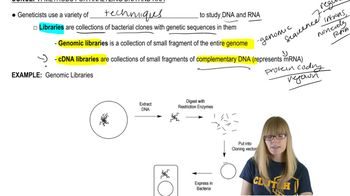Table of contents
- 1. Introduction to Genetics51m
- 2. Mendel's Laws of Inheritance3h 37m
- 3. Extensions to Mendelian Inheritance2h 41m
- 4. Genetic Mapping and Linkage2h 28m
- 5. Genetics of Bacteria and Viruses1h 21m
- 6. Chromosomal Variation1h 48m
- 7. DNA and Chromosome Structure56m
- 8. DNA Replication1h 10m
- 9. Mitosis and Meiosis1h 34m
- 10. Transcription1h 0m
- 11. Translation58m
- 12. Gene Regulation in Prokaryotes1h 19m
- 13. Gene Regulation in Eukaryotes44m
- 14. Genetic Control of Development44m
- 15. Genomes and Genomics1h 50m
- 16. Transposable Elements47m
- 17. Mutation, Repair, and Recombination1h 6m
- 18. Molecular Genetic Tools19m
- 19. Cancer Genetics29m
- 20. Quantitative Genetics1h 26m
- 21. Population Genetics50m
- 22. Evolutionary Genetics29m
18. Molecular Genetic Tools
Methods for Analyzing DNA
Problem 14
Textbook Question
What advantages do cDNA libraries provide over genomic DNA libraries? Describe cloning applications where the use of a genomic library is necessary to provide information that a cDNA library cannot.
 Verified step by step guidance
Verified step by step guidance1
cDNA libraries are constructed from mRNA, which means they represent only the expressed genes in a particular cell type or tissue at a specific time. This allows researchers to focus on the coding regions of the genome, which are often of primary interest in gene expression studies.
Genomic DNA libraries, on the other hand, contain fragments of the entire genome, including non-coding regions, regulatory elements, and introns. This makes them useful for studying the complete genetic makeup of an organism, including gene regulation and structural features.
One advantage of cDNA libraries is that they are smaller and easier to screen than genomic libraries because they contain only the expressed genes. This is particularly useful in identifying and studying genes that are actively being transcribed.
However, genomic libraries are necessary when the goal is to study the entire genome, including non-coding regions, or when the interest is in understanding gene regulation, chromosomal structure, or evolutionary studies.
Applications where genomic libraries are essential include identifying regulatory sequences, studying gene organization and structure, and performing comparative genomics to understand evolutionary relationships.
Recommended similar problem, with video answer:
 Verified Solution
Verified SolutionThis video solution was recommended by our tutors as helpful for the problem above
Video duration:
1mPlay a video:
Was this helpful?
Key Concepts
Here are the essential concepts you must grasp in order to answer the question correctly.
cDNA Libraries
cDNA libraries are collections of complementary DNA synthesized from messenger RNA (mRNA) through the process of reverse transcription. They represent only the expressed genes in a cell at a specific time, allowing researchers to study gene expression and protein coding sequences without the non-coding regions found in genomic DNA.
Recommended video:
Guided course

Methods for Analyzing DNA and RNA
Genomic DNA Libraries
Genomic DNA libraries contain fragments of an organism's entire genome, including both coding and non-coding regions. This comprehensive representation is essential for studying the complete genetic makeup, regulatory elements, and non-coding RNA genes, which are not captured in cDNA libraries.
Recommended video:
Guided course

Genomic Variation
Cloning Applications
Cloning applications often require genomic libraries when researchers need to isolate and study specific genes, regulatory sequences, or non-coding regions that are crucial for understanding gene function and regulation. For example, genomic libraries are necessary for mapping complex traits or identifying mutations in non-coding regions that may affect gene expression.
Recommended video:
Guided course

Positional Cloning

 7:40m
7:40mWatch next
Master Methods for Analyzing DNA and RNA with a bite sized video explanation from Kylia Goodner
Start learningRelated Videos
Related Practice

